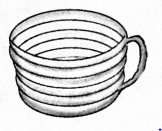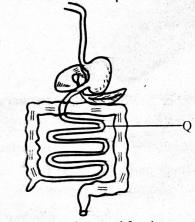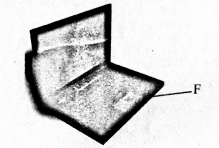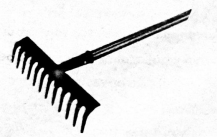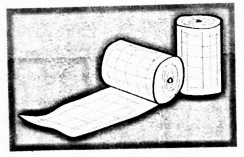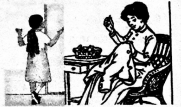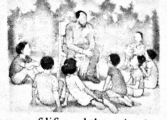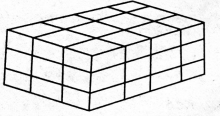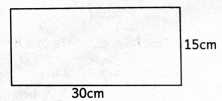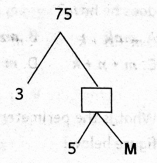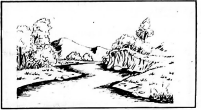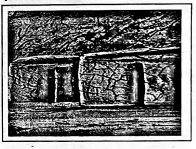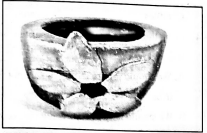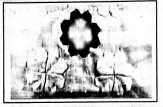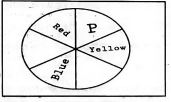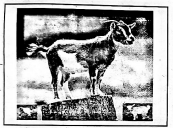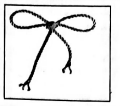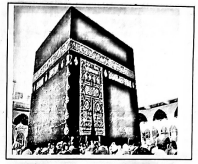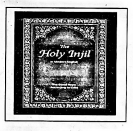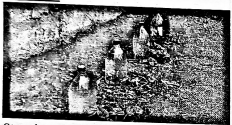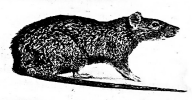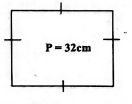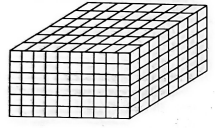Stella
Creative Arts & Social Studies Questions - Grade 5 Opener Exams Term 2 2023 Set 2
ART AND CRAFT
- What are primary colours? They are
- colours obtained from nature.
- colours obtained from mixing secondary colours.
- colours found in natural state that not two colours can be added to obtain them.
- mixed secondary and tertiary colours.
- Which of the following is not a secondary colour?
- Red
- Blue
- Yellow
- Orange
- The main reason why we apply colour to a painting is to
- add value
- add tone
- add shape
- add light
- The main reason why we include wefts in basketry is to
- provide a framework for the basketry
- create beauty.
- create shape.
- make the basket weak and flexible.
- Strips of leather that can be used to join two or more pieces of leather are known as
- thongs
- hides
- mallets
- rafts
- The item below was modelled using clay. The technique used to make the item below is called
- pinch technique.
- slab technique.
- coil technique.
- thumb technique.
- The techniques used to finish the edges of a mat neatly after weaving is
- stitching and binding.
- plaiting and twining.
- binding and weaving.
- weaving and plaiting.
- The element that emphasizes on repetition is
- rhythm and movement
- balance
- proportion
- space
- Alice is mixing clay thoroughly by pressing it over and over again until moisture is evenly distributed. What she is doing is known as
- stamping
- incising
- embossing
- kneading
- What element shows smoothness and roughness of a surface?
- Texture
- Value
- Tone
- Colour
MUSIC
- The following are aspects of a folk song except
- message
- occasion
- instrumentation
- age
- The East African Community Anthem is sung during the following occasions except one. Which one is it?
- At the East African Community Meetings.
- During flag hoisting ceremonies.
- During birthday parties.
- During East African Community regional events.
- The following are parts of the body that we can easily use to create rhythm while singing. Which one is not?
- Mouth
- Hands
- Legs
- Ears
- How do we tune a drum?
- By hitting the drum.
- By plucking the leather strips.
- By sundrying the membrane.
- By tanning the laces.
- What do we call songs sung in praise of a country or leaders?
- Religious songs.
- Topical songs.
- Patriotic songs.
- Action songs.
- The following is a musical wind instrument.
It is played by- bowing
- plucking
- blowing
- rubbing
- Which of these combinations shows solfa notes in ascending order?
- doh, mi, reh
- doh, reh, mih
- mih, re, doh
- reh, doh, mih
- The following are values we learn from singing. Which one is not?
- Kindness
- Unity
- Greed
- Honesty
- The following are ways of handling descant recorder. Which one is not?
- Keep it where there is enough sunshine.
- Clean it before use.
- Do not drop it down to avoid breakage.
- Keep it in a dry place.
- Which of the following is a safety measure that should be observed when dancing?
- Use sharp props.
- Dance when you are very close to each other.
- Dance when wearing heavy metallic ornaments.
- Avoid hitting each other while dancing
SOCIAL STUDIES
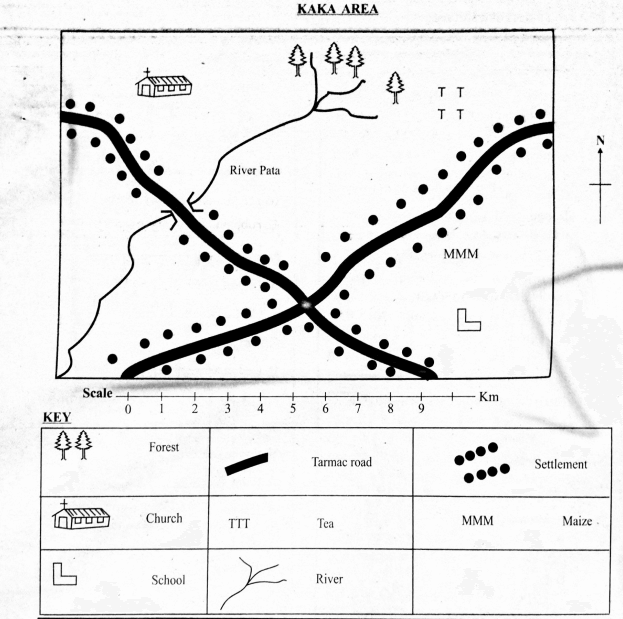
Study the map of Kaka area and answer questions 21-25
- What is the title of the area represented in the map?
- Kaka area
- Pata area
- Koko area
- Kiboko area
- The main cash crop grown in the area is
- maize
- tea
- coffee
- rice
- Many people in the area are
- Christians
- Muslims
- Hindus
- Pagans
- The population distribution pattern in the area is
- clustered
- sparse
- linear
- dense
- The forest in the area is found in which direction of the map?
- South
- North
- East
- South
- Which country boarders Kenya'to the East?
- Somalia
- Uganda
- Tanzania
- Ethiopia
- Grade 5 learners were asked by their teacher to name the elements of a map. Who gave a wrong response?
- Mweru - frame
- Mwai - scale
- Onyango - key
- Kiprono - colour
- Which of the following is a cardinal point of a compass?
- North West
- North East
- South West
- East
- Grade 5 learners went for an educational trip to Mombasa. They saw one of the historical built environments. This historical built environment was
- Indian Ocean
- the Coastal beaches
- Fort Jesus
- Dedan Kimathi statue
- Which one of the following is not a drainage feature?
- River
- Lake
- Ocean
- Plateau
- Which among the following is not a Bantu speaking community?
- Maasai
- Agikuyu
- Akamba
- Abaluhya
- Traditional methods of instruction in traditional education include all the following except
- use of riddles
- use of proverbs
- use of stones
- use of books
- Which one of the following is not a function of the head teacher in a school?
- Keeps school records.
- Keeps record of money.
- Admits new pupils.
- Prepares the school timetable.
Use the map below to answer questions 34 and 35.
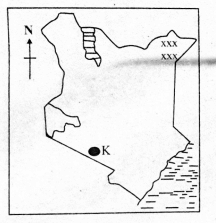
- The lake marked K is known as
- Lake Victoria
- Lake Turkana
- Lake Nakuru
- Lake Magadi
- The main language group that is found in the region marked xxx is
- Bantus
- Nilotes
- Cushites
- Europeans
C.R.E
- According to Genesis 3:1-13, Adam and Eve sinned against God when they
- hid themselves from God
- ate the forbidden fruit
- spoke to the serpent
- separated from each other
- Human beings are special in God's creation because
- they were last to be created.
- they look like God.
- they can speak.
- they were created in the image and likeness of God.
- Which one of the following is not a gift of the Holy spirit?
- Healing
- Wisdom
- Peace
- Working miracles
- The early believers did the following except
- shared meals together
- shared their belongings with each other
- fellowshipped together
- persecuted others together
- The lesson Christians learn from the parable of the three servants is that
- we should use our God given abilities wisely
- we should use our abilities for our own use
- we should not help those who are not our friends
- we should use our abilities to serve family members only
- The Bible was written by
- God Himself
- the Holy spirit
- people inspired by the Holy spirit
- different people from different parts of the world.
- When Moses was called by God he was living in the land of
- Midian
- Egypt
- Canaan
- Judea
- .......Your sins are forgiven. "Get up and walk."
During which miracle did Jesus say these words?- Healing of the blind man.
- Changing water into wine.
- Raising of Lazarus.
- Healing of the paralysed man.
- Complete the beatitude below.
..."Happy are the merciful for God will...- be merciful to them
- comfort them
- forgive them
- bless them
- Three of the following are rites of passage in Traditional African Societies. Which one is not?
- Birth
- Baptism
- Marriage
- Death
- Which one of the following parables of Jesus teaches Christians that they should be persistent in prayer?
- Friend at midnight
- The pharisee and the tax collector
- The lost coin
- The mustard seed
- Who among the following healed the mother-in-law of Simon Peter?
- Peter
- Paul
- Jesus
- James
- When king Solomon wanted to rule the Israelites well, he asked God for
- wisdom
- wealth.
- good health
- knowledge
- In which town did Jesus meet Zaccheaus?
- Cana
- Jericho
- Jerusalem
- Bethany
- While playing in the field, you find a one hundred shillings note. As a Christian, what action will you take?
- Leave it there for the owner to find it
- Take it there for your own use
- give it to the head teacher to find the owner.
I.R.E
- Salim a grade six learner is planning to perform Swalatul Isha. Which of the following will be the first thing for him to do?
- Perform wudhu
- Face Qiblah
- Say the Shahada
- Put on a clean clothe
- Which surah of the Quran helps a Muslim to understand the oneness of Allah (S.W.T)?
- Al-Falaq
- An Naas
- Al-Ikhlas
- Al- Maun
- How many verses are there in surah Al-Fatiha?
- Six
- Seven
- Eight
- Ten
- Abdul Jabal was discussing with his friends about the revealed scriptures. Which of these scriptures was revealed to prophet Daud (A.S)?
- Taurat
- Suhuf
- Qur'an
- Zabur
- "Pray and sacrifice to your Lord. "This quotation is a verse from surah
- Maun
- Ikhlas
- Falaq
- Kauthar
- You have a friend who does not wear clothes that cover her nakedness. Which of the following will not be a good advice for you to give her?
- Respect yourself
- Be a role model
- You look nice
- Follow the Quran's hadith
- What should a Muslim say after eating?
- Maashallah
- Alhamdulillahi
- Bismillahi
- Subhanallah
- Salma a grade five learner likes being clean and brushes her teeth oftenly. Which one of the following times is Salma not required to brush her teeth?
- In the morning
- Before laughing
- Before sleeping
- After eating
- Allah (S.W.T) is known as the king of kings. This is the same as
- Al-Malik
- Al-Razzak
- Al-Khaaliq
- Al-Wadud
- While researching using a digital device on the prophets, Kheri came across prophets who are known as Ulul Azmi. Who among the following is not one of Ulul Azmi prophets?
- Musa
- Ibrahim
- Issa
- Adam
- What is the meaning of the term twahara?
- Wudhu
- Istinjai
- Cleanliness
- Uncleanliness
- While playing in the school playground, Ismail a grade five learner was licked by a dog. Which type of najasaat did he find himself in?
- Mutawasita
- Mughalladha
- Mukhafafa
- Hadath Akbar
- The nakedness of a Muslim man is between the knees and the
- navel
- head
- stomach
- feet
- Three of the following are duties of a child to his parents. Which of them is not?
- Caring for them
- Praying for them
- Helping them with work
- Quarelling them
- Who was the foster mother of prophet Muhammad (S.A.W)?
- Halima
- Amina
- Hawa
- Maryam
Integrated Science Questions - Grade 5 Opener Exams Term 2 2023 Set 2
SCIENCE AND TECHNOLOGY (15marks)
- During a science lesson, a learner drew a diagram of the human digestive system on the board as shown below. What is the function of the part labelled Q?
- Stores undigested food materials
- Absorption of water and mineral salts
- Stores food temporarily before it is digested
- Absorption of digested food materials
- During a science lesson, learners agreed that a goat and a mango tree had many things in common. Which one of the following is not common between the two?
- Remove waste
- Give birth
- Grow
- Die
- Grade 5 learners were discussing about waterborne diseases in our community. Which among the following diseases that they discussed about is odd one out?
- Dysentery
- Malaria
- Bilharzia
- Typhoid
- In the environmental conservation project preparation, learners were asked to prepare adequately for the activity. Among the following, which one was not necessary for the activity?
- Vest
- Gloves
- Gumboots
- Gas mask
- The diagram below represents a simple machine.
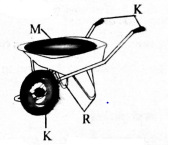
Which part of the wheelbarrow represents the fulcrum?- M
- K
- Q
- R
- One fine morning, grade 4 learners listed characteristics of a certain type of clouds as follows
- Found low in the sky
- Produce rain
- Grey in colour
- Cover large part of the sky
Which type of clouds were the learners describing?- Nimbus
- Stratus
- Cirrus
- Cumulus
- The following are characteristics of a certain vertebrate as listed by grade 5 learners. Which among the characteristics was wrongly listed for a
duck billed platypus?- Breathes using lungs
- Lays eggs
- Has scales on the feet
- Body temperature is constant
- Animals may cause harm to us in different ways. Among the following, what should not be done when interacting with animals?
- Kill the animal incase it causes harm
- Wear gumboots when working in grass
- Wear hand gloves.
- Avoid getting too close to some animals
- A learner listed functions of skeletal muscles as follows. Which one among them is not true?
- Enable movement of parts of the body
- Support other body parts
- Enable us to stand upright
- Weaken the body
- Grade 4 learners observed the digital device drawn below.
What is the name of the part marked F?- Monitor
- Keyboard
- Touch pad
- Mouse
- During an experiment, grade four learners heated a metalic rod at one end. Ouma was able to feel the heat at the other end. What made Ouma to feel the heat at the other end?
- Conduction
- Convection
- Radiation
- Melting
- Which part of the human skeleton protects the spinal cord from injuries and also enables one to be able to walk upright?
- Hind limbs
- Skull
- Rib cage
- Back bone
- The following are characteristics of human teeth
- sharp and pointed
- have one root
- used for tearing flesh
Which type of tooth is most likely described above?- Canine
- Molars
- Incisors
- Premolars
- Fungi are both beneficial and harmful to human beings. Among the following fungi, which one is important in the baking industry?
- Mushroom
- Puffballs
- Moulds
- Yeast
- Grade 5 learners were discussing about the parasites. They listed the following as external parasites except
- flea
- mite
- pinworm
- louse
AGRICULTURE (10 marks)
- During an agriculture lesson, grade 4 learners were discussing about the gardening practices that are carried out on container gardening after planting. Among the following practices, which one was wrongly stated?
- Thinning
- Pruning
- Weeding
- Controlling pests
- The following are types of soils that were brought by learners to class for an experiment. Which type of soil is the best in water retention?
- Clay
- Silt
- Sand
- Loam
- Three of the following are uses of water in the farm. Which among them is incorrect?
- Cooking
- Watering animals
- Washing farm tools
- For irrigation
- During an Agriculture lesson, grade 4 learners were discussing about domestic animals and their products. Among the following, which one represents the products for goats and sheep respectively?
- Milk and beef
- Wool and beef
- Milk and wool
- Mutton and milk
- Three of the following are legume crops that are grown in Kenya. Which among them is the odd one out?
- Cow peas
- Sorghum
- Green grams
- Peas
- The diagram below shows a certain farm tool used by a farmer when preparing seed bed.
How did the farmer use the tool?- For digging
- For levelling the seedbed
- For adding manure
- For removing the seedlings
- During a nature walk, grade 5 learners came across a farm near their school. The farmer grows different types of climbing fruits. Among the following, which one were the learners not able to see in the farm?
- Thorn melon
- Blackberries
- Kiwi
- Raspberries
- Mama Otieno prepared kales and spinach for lunch. She also added tomatoes and carrots.Which of the following does not show the importance of the food prepared by Mama Otieno?
- Protect the body against diseases
- Keep the skin healthy
- Provide the body with energy to do the work
- Help in healing the wounds
- After planting carrot plants in the seed bed, they germinated in excess. Among the following practices, which one would help the farmer to get healthy carrot plants?
- Pruning
- Thinning
- Watering
- Weeding
- The following are different ways of maintaining farm tools and equipment. Which one is the most appropriate way of maintaining a wheelbarrow for easier movement?
- Sharpening
- Cleaning
- Painting
- Greasing
HOME SCIENCE (10 marks)
- Cynthia is preparing to attend a graduation ceremony of his friend who has completed his engineering course. She is ironing the clothes she will wear. Which one of the following is the best reason why she is ironing her clothes?
- To look smart
- To feel warm
- To dry the clothes
- To remove bad smell
- Kemuma wants to buy shoes for her daughter. Which one of the following is a factor Kemuma should consider when buying the shoes?
- Friends of the daughter
- Time of the day
- Size of the shop
- The occasion
- A grade 5 girl was asked to write a shopping list for the things she will use em. She wrote as follows. for second
- 3 packets of sanitary towel
- Nice and lovely 100ml lotion
- One dozen of exercise books.
Which important information was missing in her shopping list.- Quality of the items
- Quantity of the items
- Cost of the items
- Where to buy the items
- Below are methods of cooking food. Which is the best method to cook chapati?
- Boiling
- Roasting
- Smoking
- Shallow frying
- The lists below contain different types of foods. Which list contains foods that belong to the same group?
- Tomatoes, onions, kales
- Chicken, beans, potatoes
- Fish, beef, ycam
- Ugali, chapati, green grams
- Grade five learners were learning about time management. They were asked by their teacher to state the benefits of time management. They gave their answers as follows.
Nancy: Enables one to meet targets
Brenda: Enhances speed when performing a task
Tito: It shows punctuality
Grace: It leads to wasting time
Who gave a wrong response?- Nancy
- Grace
- Brenda
- Tito
- You are planning to sell your products within your locality. What is the best way to get customers to buy your products?
- Sell at a cheaper prize
- Sell at a higher prize
- Advertise your products
- Give products at a debt
- Which one of the following is a healthy habit?
- Brushing your teeth once in a day
- Taking alcohol
- Not bathing during cold seasons
- Brushing your teeth twice in a day
- The items below are used for cooking.. Which item uses kerosene?
- Open fire place
- Gas cooker
- Charcoal cooker
- Stove
- Mrs. Wahome uses the tool below during her needlework.
The tool is known as- needle threader
- spool wrap
- thimble
- thread organiser
PHYSICAL AND HEALTH EDUCATION (15 marks)
- When performing medium sprint start at the command "on your marks", which position should the body assume?
- Bending
- Legs spread
- Crouch position
- Streamlined
- Straddle and straddle cross are rope work techniques. Which one of the following is the main difference between the two?
- In straddle cross legs are apart
- In straddle legs cross each other
- In straddle cross legs cross each other
- They are performed in the same day
- In standing discus, boys and girls of 13 years throw discus of different weights. What is the preferred weight for girls?
- 1 gram
- 0.75 kilograms
- 0.75 grams
- 1 kilogram
- The following steps can be used to improvise a relay baton. Arrange them in the correct order.
- Put pieces of newspaper to fill the hollow part
- Cut the top parts of plastic bottles
- Fold the ends of the manilla paper
- Join the bottles
- Collect the materials
- Wrap the bottles using the manilla paper
- (v), (ii), (iv), (i), (vi), (iii)
- (i), (ii), (iii), (iv), (v), (vi)
- (vi), (iv), (ii), (iii), (i), (v)
- (iii), (i), (iv), (v), (vi), (ii)
- The following are important rules to be followed while performing long jump. Which one is not?
- Take-off foot should not cross the take-off board
- Use quick long strides on the runway
- Take-off foot to cross the take-off board
- Land with the knees bent.
- Participating in running activities has got the following health benefits except
- makes bones stronger
- brings heart diseases
- relieves stress
- relaxes the body
- Papier mache paste is a material used to improvise a discus. The following steps are followed while making the paste. Which one is the third step?
- Squeeze excess water from soaked newspaper
- Soak newspapers in salty water
- Put wheat flour in water and stir well
- Mix wheat paste and the soaked newspaper.
- When performing racing games observe the following measures except
- avoid crowding
- pick and remove foreign objects
- cross in front of others as you run
- wear sports clothing
- The following factors should be considered while performing first aid on an injured person. Which one should be considered first before any other?
- Shout for help
- Observe your safety and that of the casualty
- Check if the casualty is breathing
- Check for the airways of the casualty
- The person who judges in the game of football and issues cards when one makes a foul is referred to as
- linesman
- fans
- coach
- referee
- The equipment below is found in a first aid kit. Name it.
- Cotton wool
- Cloth
- Mattress
- Bandage
- The following are techniques used in long jump. Which is the second?
- Take off
- approach
- Landing
- Flight
- The equipment below is an athletic track. Name the part marked Y.
- Line
- Space
- Lane
- Track
- Why should you wear gloves when handling a classmate who is nose bleeding?
- To make the hands look smart
- To avoid infections
- To keep the hands warm
- Fear of seeing blood
- During the inter-school games one of the players hurt his knee and required first aid. Which of the following is not a reason for providing first aid to the injured player?
- To save life of the injured player
- To prevent the injury from getting worse
- To receive payment for assisting the player
- To help the injured person recover faster.
Shughuli za Kiswahili Questions and Answers - Grade 5 Opener Exams Term 2 2023 Set 2
KUSIKILIZA NA KUZUNGUMZA
Soma mazungumzo yafuatayo kisha ujibu maswali
(Nyanya ameketi chini ya mti akifuma sweta. Anaiweka sweta kando anapomwona Wakesho)
Wakesho : (akimkaribia nyanya) Shikamoo nyanya?
Nyanya : (kwa tabasamu) Marahaba mjukuu wangu! Habari za shule?
Wakesho : Njema nyanya! (kimya) Nyanya, nikwambie kitu?
Nyanya : Naam, niambie mjukuu wangu.
Wakesho : Wenzangu walinichagua kuwa kiranja wa darasa.
Nyanya : Hongera! Jambo zuri sana.
Wakesho : (akijikuna kichwa). Lakini Nyanya, sijui ninastahili kufanya nini ili niwe kiongozi bora.
Nyanya : Aha! Wakesho, sikiliza. Ili kuwa kiongozi bora unastahili kuwa na maadili.
Wakesho : Ooh! Maadili
Nyanya : Naam mjukuu wangu. Unaweza kuonyesha maadili kwa namna mbalimbali. Kwanza usiwe na ubaguzi unapowahudumia wenzako.
Wakesho : Kweli Nyanya, ninafikiria pia ninastahili kuwa na upendo.
Nyanya : Ndiyo Wakesho. Unaweza kufanya hivyo kwa kuwajali na kuwasaidia wenzako wanapokuwa na shida.
Wakesho : Kweli Nyanya! Ninaona kwamba ushirikiano ni jambo muhimu.
Nyanya : Haswa! Kidole kimoja hakivunji chawa. Je, unaweza kushirikiana na wengine kwa njia gani?
Wakesho : (Kwa ujasiri) Kwa kuwahusisha katika mambo mbalimbali.
Nyanya : Vyema! Unastahili pia kuwa na uaminifu. Tunaonyesha uaminifu kwa kusema ukweli na kufanya mambo inavyostahili.
Wakesho: Asante Nyanya! Hakika umenifunza mengi.
- Wakesho alipoulizwa na Nyanya kuhusu habari za shule alimjibu vipi?
- Naam
- Njema
- Shikamoo
- Marahaba
- Ni neno gani ambalo nyanya alitumia kumpongeza Wakesho kwa kuchaguliwa kuwa kiranja?
- Hongera!
- Naam
- Ndiyo
- Haswa!
- Kulingana na kifungu, kiongozi mwema hafai kuwa na ____________________________
- ushirikiano
- heshima
- upendo
- ubaguzi
- Baada ya mazungumzo haya Wakesho anafaa kufanya nini?
- Kufurahia kuwa kiongozi shuleni.
- Kufuata mawaidha ya nyanya
- Kueleza wenzake kuhusu nyanya yake
- Kuwashukuru wenzake
- Maadili ni nini?
- Ushauri
- Kuwajali wengine
- Uongozi mzuri
- Mwenendo mzuri
Swali la 6 hadi la 9
Soma kifungu kifuatacho kisha ujibu maswali.
Simba mwenye njaa, katika pitapita zake za kuwinda, alimkuta Sungura akiwa amelala fofofo. Alishusha pumzi, akatabasamu na kumshukuru sana Mungu kwa ukarimu wake wa kumpatia chakula bila kukifanyia kazi.
Taratibu alimsogelea Sungura ili asije akamwamsha, akalala yeye... Alipoinua miguu yake kutaka kumkamata, mara akatokea swara mnono ambaye alipita akikimbia karibu naye, akielekea upande wa kaskazini kwenye nyasi fupi.
Simba alimwacha Sungura na kumkimbiza yule Swara.Kelele za Simba akimkimbiza swara zilimgutusha na kumwamsha Sungura ambaye aliamka na kutimua mbio kuelekea upande wa kusini.
Baada ya kumkimbiza swara kwa muda mrefu Simba alishindwa na kuamua kurudi ili akamle yule Sungura.
Alipogundua kuwa Sungura naye alikuwa ameamka na kukimbia, Simba alisema kwa kujilaumu, "Ama kweli nimepata nilichostahili; kwa kuwa nilikiacha chakula nilichokitia mkononi tayari kwa tamaa ya kutaka kupata zaidi."
- Ni wanyama wangapi waliotajwa katika kifungu hiki?
- Watatu
- Wawili
- Wanne
- Mmoja
- Kati ya wanyama walio kwenye kifungu ni yupi hali nyasi?
- Swara
- Sungura
- Simba
- Wote
- Hadithi hii inatufunza nini?
- Tuwe na ukarimu
- Tusiwe na tamaa
- Tukifanya makosa tujilaumu
- Tuwe watu wenye shukrani
- Kinyume cha kitenzi tabasamu ni nini?
- Cheka
- Lia
- Nuna
- Waza
Swali la 10 hadi la 12
Soma kifungu kifuatacho kisha ujibu maswali.
Wanafunzi wa gredi ya tano katika Shule ya msingi ya Faulu walipewa mradi wa kutafuta aina mbalimbali za mapambo kwenye mtandao.Wanafunzi waligawanywa katika vikundi vinne kama ifuatavyo: Starehe, Amani, Upendo, Nuru. Kila kikundi kilitafuta mapambo yake. Tazama jedwali hili kisha ujibu maswali
| VIKUNDI | Mapambo | Mapambo | mapambo |
| Starehe | Herini | Pete | Mkufu |
| Amani | Mkufu | Bangili | Herini |
| Upendo | Pete | Mkufu | Bangili |
| Nuru | Bangili | Herini | Pete |
- Ni kikundi kipi hakikupata mapambo ya masikioni?
- Starehe
- Upendo
- Amani
- Nuru
- Ni kikundi kipi hakikupata bangili?
- Nuru
- Amani
- Upendo
- Starehe
- Ni kikundi kipi hakikupata pambo la shingoni?
- Starehe
- Upendo
- Nuru
- Amani
Swali la 13 hadi la 15
Soma kifungu kifuatacho kisha ujibu maswali.
Huduma ya kwanza ni muhimu sana katika maisha yetu. Mtu hupewa huduma ya kwanza anapopata ajali au anapokuwa mgonjwa. Huduma ya kwanza humsaidia mwathiriwa aweze kufika kwa daktari ili kupata matibabu. Mtu akikosa kupewa huduma ya kwanza anaweza akaaga dunia.
Shuleni kuna ajali mbalimbali ambazo hutokea. Ajali hizi ni kama vile: Kuzirai, kuteguka mguu, kuvunjika viungo vya mwili, kuchomeka, muhina (kutokwa na damu puani) kukatwa na kifaa chenye makali na kuumwa na mdudu.
Mtu akizirai kagua kama ameumia kwanza. Kisha mbebe hadi mahali penye hewa safi kama vile kivulini, mlaze chali na uinue miguu yake juu kidogo. Legeza mavazi yaliyombana kwa kufungua mshipi wake, ukosi au mavazi mengine yaliyombana ili apate hewa safi.
Mtu akitokwa na damu puani, mketishe wima huku akiinama upande wa mbele, finya taratibu sehemu iliyo laini ya pua na umwagize apumue kupitia mdomoni kisha uendelee kufinya taratibu kwa muda wa dakika kumi hadi kumi na tano. Mpatie hanchifu ashikilie upande wa pua.
Njia hizi na nyingine ni muhimu kuzijua ili kuweza kuokoa maisha.
- Umuhimu wa huduma ya kwanza ni gani?
- Kumwezesha aliyeumia kufika kwa daktari.
- Kumsaidia mwathiriwa apone.
- Kuleta pesa kwa anayefanya huduma ya kwanza.
- Kumsaidia mwathiriwa kuaga dunia.
- Ni nini maana ya msemo kuaga dunia?
- Kuhamia nchi nyingine
- Kupona
- Kufa
- Kupata nafuu.
- Ni njia ngapi za kufanya huduma ya kwanza zilizoelezewa?
- Moja
- Tatu
- Nne
- Mbili
Soma kifungu kifuatacho. Kina nafasi 16 hadi 20. Umepewa majibu manne hapo. Chagua jibu lifaalo zaidi kati ya yale uliyopewa.
Katika gredi ya tano tumefunzwa mambo __16__. Katika matamshi bora mtu anafaa kusema__17__anapomaanisha kuosha nguo. Vilevile sasa najua kuwa kwaheri ni aina ya __18__. Isitoshe ninaweza kutega na __19__ vitendawili. Zaidi ya hayo ninafahamu kuwa kikosi cha askari ni nomino ya __20__.
| A | B | C | D | |
| 16. | mengi | mingi | vingi | wengi |
| 17. | fua | mvua | vua | vuka |
| 18. | salamu | methali | tashbihi | maangano |
| 19. | kutegua | kujibu | kufumbua | kutegewa |
| 20. | wingi | makundi | kitenzi-jina | dhahania |
Swali la 21-30
SARUFI
Kutoka swali la 21 hadi 30, chagua jibu sahihi.
- Ni picha gani haijaambatanishwa sawasawa na nomino yake ya makundi?
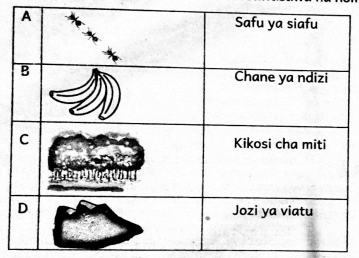
- Watoto wenye nidhamu, huheshimu walimu ____________________A
- wao
- yao
- zao
- vyao
- Anwanipepe hutumika katika uandishi wa
- Barua rasmi
- Barua ya kirafiki
- Baruapepe
- Barua ya kiofisi
- Chagua wingi wa: Nyumba yangu inapendeza
- Nyumba yetu inapendeza.
- Majumba yetu yanapendeza.
- Vijumba vyetu vinapendeza.
- Nyumba zetu zinapendeza
- Zawadi alimsaidia Nuru kuchora picha. Kwa hivyo Zawadi
- alimchoresha Nuru picha.
- alimchorea Nuru picha.
- alichoreshwa picha na Nuru.
- alichoreshea Nuru picha.
- Ni sentensi ipi sahihi?
- Chakula hizi imeiva.
- Mti huu umekatwa.
- Giza hili linatisha.
- Gazeti hii imesomwa.
- Ni sentensi ipi iliyoakifishwa vyema?
- Nimefurahi sana!
- Ninajua kutumia dira?
- Tulicheza soka, chesi na jugwe.
- Ngombe ni mnyama mzuri.
- Chagua ukubwa wa nomino mto:
- Kito
- Kijito
- Jito
- Mito
- Chagua jibu lisilo sahihi.
- Fupi kama nyundo
- Miguu mirefu kama korongo
- Mrefu kama mlingoti
- Shingo ndefu kama mbilikimo
- Kamilisha Methali hii: Mtoto umleavyo ____________________________________
- huvunjika guu
- hutazama kisogo cha nina
- hufunzwa na ulimwengu
- ndivyo akuavyo
KISWAHILI: INSHA
Andika insha kuhusu mada ifuatayo:
SIKU NILIYOFURAHIA SANA
English Language Activities Questions - Grade 5 Opener Exams Term 2 2023 Set 2
Read the following dialogue and answer questions 1-5.
Reporter : Hello, my name is Mr James. I am a reporter for KNN and would like to meet Mr Joel.
Receptionist : Do you have an appointment?
Reporter : I do not have a formal one, but I spoke to him on the phone and he said that I could come today.
Receptionist : You will have to wait for some time since Mr. Joel is in a meeting right now.
Reporter : How long will the meeting last?
Receptionist : It should be over in about thirty minutes.
Reporter : That is fine with me.
Receptionist : Would you like some tea or coffee?
Reporter : No, thanks for asking.
Receptionist : You're welcome. Please have a seat. I will let you know as soon as he is free.
Reporter : I appreciate your co-operation.
- Which word from the dialogue above means a professional who manages the front desk of an organisation?
- Reporter
- Appointment
- Receptionist
- Meeting.
- The reporter agreed to wait. We can say he was as patient as a ______________________
- Job.
- doctor
- mother
- cow
- The following words can be used to replace the word reporter except
- newsman.
- journalist
- author
- newswriter
- Which statement below is true?
- The reporter had a formal appointment
- The reporter talked to Mr. Joel on phone
- The reporter chose to take tea
- The reporter was called Mr. Joe
- Why couldn't the reporter meet Joel right away?
- He was patient
- The meeting was ending in thirty minutes
- Joel was in a meeting
- James was in a meeting
Read the poem below and answer questions 6 to 8
I started this life with fear, I was only six years old.
When I started to realize, that girls world is cold.
Just like a useless device, it's not right to complain.
I should withstand all emotional and physical pain.
I heard that one of my friends became a hero.
Because she took the out-dated cut.
That makes her so, a member of a cult
I knew my day would soon come anyway
It was never an option, it was compulsory
I had to bite my lips, hold back my tears
As I feel the knife's tip, as it painfully tears.
I grew up in pain of waiting for pain
Seeking for something to separate us
But people still wanted to hurt me
I got used to everything even if so horrible..
I guess they never cared about my emotion.
Or they would empathize knowing the sensation.
Inside me was a tremendous commotion.
I was lost in an invisible and painful ocean.
F. G. M is a nightmare, oh come the golden age.
When it will all vanish, wait for the golden age.
Come end this punishment, get me out of the cage.
- The writer of the poem is _______________________
- a young girl
- a young boy
- an old man
- an old woman
- The writer grew up in pain of waiting for ___________________________
- female genital mutilation.
- early, marriage.
- being buried
- death
- The best title for the poem is _______________________
- child rights
- out-dated hero
- the pain of girls
- Female genital mutilation.
Read the passage below and answer questions 9-11
A folktale is a story passed down verbally from generation to generation. Each storyteller added something new to the stories, making them more interesting, fascinating and relevant as the ages passed. Different folktales have the characteristics of the culture, folk life and customs of the people from which they originated especially the African folktales
Africa is the second largest continent in the world. The people from Africa included unique characteristics in their culture, showing
their way of life and the animals and plants that surround them.
African stories sometimes include trickster, animals stories and spirits narratives. A typical collection of folktales from Africa consists of tales and stories from all over Africa.
- What is the mode of passing folktales from one generation to another?
- Story books
- Verbal narrative
- Radios
- Spirits.
- What would you say about the size of Africa as a continent?
- It is the largest
- It is the smallest
- It ranks second in size
- It is the second smallest
- African stories sometimes include all the following except
- trickster
- animals' stories
- plants
- spirits' narratives.
Read the following passage and answer questions 12-15.
A budget is simply a spending plan that takes into account estimated current and future income and expenses for a specified future time period, usually a year. Having a budget keeps your spending in check and makes sure that your savings are on track for the future. Budgeting can help you set long-term financial goals, keep you from overspending, help shut down risky spending habits, and more.
A budget helps you figure out your long-term goals and work towards them. If you just drift aimlessly through life, tossing your money at every shiny, new object that happens to catch your eye, how will you ever save up enough money to buy a car or put a down payment on a house? A budget forces you to map out your goals, save your money, keep track of your progress, and make your dreams a reality. By seeing what money you earn and what money you have going out through a budget, you can create a map for where you need to go to get your goal, whether that is purchasing a home in a few years or going to graduate from school.
- Three of the following are considered when making a budget except one. Which one?
- Current expenditure.
- Future income.
- Current income
- Expenses.
- It is true to say that budget helps in the following ways except
- setting a long term financial goal
- stops overspending
- shut down risky spending habits
- makes one spend more money
- The best proverb that could be used on a person who spends without budgeting is
- A fool and his money are soon parted.
- Penny wise pound foolish.
- In for a penny in for a pound.
- Time is money
- The best title of the passage above would be
- Spending
- Budgeting
- Money
- Saving
Read the passage below keenly. It contains blank spaces numbered 16 to 20. Fill in the spaces using the best alternative from the choices given.
Life is filled with unexpected __16_. When you get sacked, become sick or injured or have a death in the family, those circumstances can __17__ to serious financial difficulty. In such situations, an emergency fund comes in handy.
An emergency fund __18__ consist of at least three to six months' worth of living expenses. __19__ it should be accounted for when budgeting. This extra money will ensure that you don't borrow from other funds saved for long-term financial __20__ such as paying off debt.
| A | B | C | D | |
| 16. | surprises | sarprises | surprices | surprice |
| 17. | lead | leads | leading | led |
| 18. | are | should | is | will |
| 19. | when | then | but | and |
| 20. | savings | work | goals | deals |
For questions, 21 to 23 choose the correct degree of adjectives to fill in the gap.
- The death of the village chief was the ______________________ thing to happen to the villagers
- sad
- saddening
- saddest
- most sad
- ________________________ days still lie ahead.
- Brightening
- Brightest
- Brighter
- Bright
- The head teacher advised us to work ________________________ in school.
- more harder
- hard
- hardest
- more hard
For questions, 24 to 26 choose the determiner from the given choices to fill in the gap.
- _________________________ worker reported late for duty today
- A little
- Little
- A fe
- Less
- The ____________________ girl handed the bouquet of flowers to the mayor..
- a little
- little
- many
- more
- Lions hunt in the morning and sleep_________________________ of the afternoon.
- more
- all
- enough
- most
For questions 27 and 28 select the correct word to fill the gap.
- Please make sure the pupils get two pencils ___________________________________
- everyone
- each
- enough
- all
- ____________________________ people don't like borrowing money from the bank.
- More
- All
- Most
- Few
For questions 29 and 30, identify an adverb in the sentences
- The teacher told us to clean the classroom yesterday.
- clean
- classroom
- yesterday
- teacher
- The Corona Virus spread fast in towns.
- Virus
- the
- spread
- fast
COMPOSITION
WRITING:
Write an interesting composition about the heading below.
ROAD ACCIDENT
Mathematics Questions - Grade 5 Opener Exams Term 2 2023 Set 2
QUESTIONS
- Write fifty two thousand, two hundred and twenty two in symbols.
- 50222
- 52222
- 52202
- 5200202
- A farmer harvested 84952 bags of rice from his farm in the year 2022. What is the place value of digit 8?
- Tens of thousands
- Hundreds
- Thousands
- Tens
- The number of tourists who visited Nairobi National park in the month of December 2018 was 408713. What is the total value of digit 7 in the number?
- Seven hundred
- Seven thousand
- Tens
- 7000
- Arrange the following numbers in ascending order
5846, 8546, 6485, 5684- 8546, 6485, 5846, 5684
- 5684, 5846, 6485, 8546
- 5846, 5684, 6485, 8546
- 8546, 5846, 5684, 6485
- During a tree planting day, 23424 trees were planted by learners. Teachers planted 23410 trees. How many trees were planted altogether?
- 46814
- 46014
- 46834
- 49814
- A cooperative society sold 43699 litres of milk in the month of January 2023. How much milk was sold to the nearest hundred?
- 43600
- 43000
- 43690
- 43700
- A farmer harvested 2500 oranges. He packed the oranges in groups of 10. How many groups did the farmer have?
- 500
- 250
- 25
- 36
- How many days are there in the mmonths of March, April and May?
- 89
- 92
- 91
- 90
- Grade five learners made the cuboid below.
How many small cubes did they use to make the cuboid?- 27
- 36
- 42
- 48
- Find the next number in the pattern
31, 29, 27, 25, 23, ____________________- 24
- 19
- 21
- 17
- Find the LCM of 30, 40 and 60
- 40
- 120
- 200
- 60
- Work out:
5.002 +2.044- 7.046
- 3.046
- 0.042
- 7.056
- Simplify: 12/18
- 6/9
- 3/6
- 4/9
- 2/3
- A lorry carries 212 bags of How many bags can 14 such lorries carry?
- 2766
- 2869
- 2968
- 2967
- Arrange the fractions below from the smallest to the largest.
1/3 , 2/4 , , 2/8- 2/8, 1/3, 2/4, 4/6
- 1/3, 2/4, 2/8 ,4/6
- 4/6, 2/4, 1/3, 2/8
- 2/4, 1/3, 2/8, 4/6
- What is the approximate height of your classroom door?
- 20cm
- 20m
- 2m
- 2cm
- Divide 948 by 6
- 150
- 185
- 148
- 158
- Which fraction is equivalent to 3/4?
- 6/12
- 6/8
- 9/16
- 1/4
- Njeri bought 385 bananas. She arranged them in 18 equal piles. how many bananas remained?
- 7
- 21
- 11
- 13
- A company sold 244682 bags of maize and beans. If 135221 bags of beans were sold, how many bags of maize did the company sell?
- 109461
- 379903
- 119461
- 111461
- Which of the following is divisible by both 2 and 10?
- 775
- 632
- 298
- 1320
- Amos has m oranges, n mangoes and k guavas. How many fruits does he have?
- mnk
- m x n x k
- m + n + k
- m − n − k
- What is the perimeter of the figure below?
- 90cm
- 45cm
- 450
- 60cm
- Add:
M cm
175 83
+ 35 65
- 210M 148cm
- 211M 48cm
- 210M 48cm
- 101M 48cm
- What is the place value of digit 4 in 27.841?
- Tens
- Hundreds
- Tenths
- Hundredths
- Find the value of M
- 25
- 3
- 5
- 15
- How many 1/4 kilograms are in 12 kilograms?
- 24
- 16
- 3
- 48
- Find the missing number
5 =
8 40- 25
- 50
- 30
- 24
The table below shows types of vehicles th at were counted by pupils from Mama Ngina Primary school.
Use it to answer questions 29-30
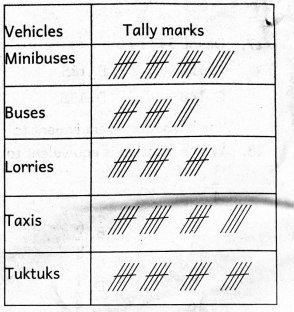
- What is the total number of lorries, taxis and tuktuks counted on that day?
- 33
- 52
- 54
- 86
- Which type of vehicles had the same number of vehicles recorded?
- Buses, lorries and Tuktuks
- Taxis and minibuses
- Minibuses, lorries and Taxis
- Buses and lorries
Social Studies, Creative Arts & Religious Studies Questions and Answers - Grade 4 Mid Term 2 Exam 2023 Set 3
PART A : SOCIAL STUDIES
Study the map of Kira Area and answer questions 1 to 5
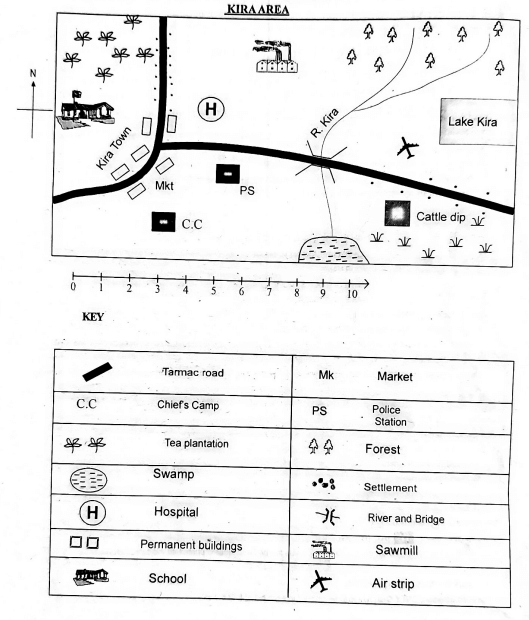
- The direction of lake Kira from the hospital is
- West
- East
- South
- North.
- River Kira drains its water into the
- Forest
- cattle dip
- Swamp
- Lake.
- Learners from Kira school named the physical features found in the area. Which one is not part of them?
- Swamp
- Lake
- Ocean
- River.
- The cattle dip is used for
- planting crops
- watering animals
- killing pests
- treating animals.
- Which of the following crops is grown for sale in Kira area?
- Coffee
- Tea
- Sisal
- Cotton.
- John drew a compass in his book. What name is given to the point between North and West?
- North East
- South West
- South East
- North West.
- Jophiel's uncle is a governor. He heads a
- county
- country
- sub-county
- town.
- Jerrica wore a heavy cloth while going to school. Which season was the area experiencing?
- Dry season
- Warm season
- Rainy season
- Hot season.
- Grade four learners were asked by their teacher to name physical features found around their school. Which one of the following did the learners not mention?
- Roads
- Mountains
- Hills
- Rivers.
- Below is a physical feature in an area. The feature shown is a
- Mountain
- ocean
- lake
- river.
The picture below shows an aspect of traditional culture. Use it to answer questions 11-15.
- The aspect of culture shown is called
- Enyumba
- Manyatta
- Moran house
- Boma.
- The aspect of culture shown belongs to which community?
- Luo
- Maasai
- Turkana
- Rendile.
- The structure above is mostly built by
- children
- men
- adults
- women
- Three of the following are sources of water. Which one is not?
- Lakes
- Rivers
- Hills
- Oceans.
- Which one of the following is a resource found in the county?
- Clouds
- Land
- Cars
- House
PART B: MUSIC
- Which of the following musical instruments is played the same way as the one shown below?
- Marimba
- Kayamba
- Flute
- Drums.
- During a Music lesson, a teacher sang a certain song. Learners listened and sang along as they touched different parts of their bodies. The song is likely to be ______________________ song.
- a happy
- a topical
- an action
- a patriotic.
- Teacher Mercy asked Grade 4 learners to present folk songs. Kyle presented a song which he accompanied with a slasher. Which occasion
is the song sung?- Birthday
- Wedding
- Funeral.
- Work.
- Maggy has been assigned the part of singing Soprano while Ben will sing bass. If they will sing together the same song, we shall say they are singing in
- harmony
- collaboration
- unison
- turns.
- If all the children at school present a song together, such performance is called
- multiple
- solo
- choral
- group.
- Belinda was asked to identify on the Kenyan flag the colour that represents vegetation. Which colour should she choose?
- White
- Black
- Red
- Green.
- Who among the following pupils did not misbehave when the Kenyan National Anthem was being sang?
- Pat- Stood at ease.
- Carol-Sang loudly on top of her voice.
- Zack-Sang faster than the rest.
- Kim-Stood at attention.
- When a certain song was being sung, learners were responding in different ways. Which of the following was a negative response?
- Nodding.
- Shouting
- Clapping.
- Stamping
- Learners improvised some musical instruments to use during devotion. Which one of the following produced the loudest sound?
- Plastic bottles.
- Wooden materials.
- Rubber shoes.
- Metalic tins.
- While singing the Kenya National Anthem, Musa kept silent when he reached the second line of the second verse. What should he sing?
- Tufanye sote bidii.
- Natukae na undugu, amani na uhuru.
- Ee ndio wajibu wetu.
- Ilete baraka kwetu
PART C: ART AND CRAFT
Tony made the artwork below. Use it to answer questions 26 to 29.
- Which of the following is not an embellishment that can be used on the above artwork?
- Beads
- Sand
- Broken glass
- Piece of cloth
- The artwork above was likely to have been created using the
- coiling technique
- kneading technique
- pinching technique
- cutting technique.
- The above artwork can be used for the following purposes except
- cooking
- displaying flowers
- putting keys
- putting stationery.
- Which of the following decoration techniques has been used in the above artwork?
- Applique
- Embedding
- Incising
- Scratching.
- Which of the following is a natural material that can be used to make the above artwork?
- Plasticine
- Clay
- Rubber
- Leather.
Keli displayed the fabric below. Use it to answer questions 31 to 33.
- Which of the following techniques was used to decorate the fabric above?
- Montage
- Collage
- Applique
- Sewing.
- The outline of the decoration above can be described as
- Wavy line
- Zigzag line
- Broken line
- Spiral line.
- Angela listed the following tools and materials. Which of them cannot be used to decorate the above fabric?
- Thimble
- Needle
- Adhesives
- Pen.
- A grade 4 learner listed the following tools. Which of the following tools cannot be used in drawing?
- Sharp tools
- Pencil
- Charcoal
- Pastel.
The figure below was drawn by a grade 4 pupil.
- The picture above is called a
- decoration
- colour wheel
- pyramid
- triangle.
PART 2: Choose a section you have prepared for. Each section is 15 marks.
CHRISTIAN RELIGIOUS EDUCATION
- Naaman, a man who was healed by prophet Elisha was suffering from
- blindness
- leprosy
- possession
- diabetes.
- Which of the kings of Israel ordered the people to bow down and worship idols?
- King Nebuchadnezar
- King Ahab
- King Saul
- King David.
- Shadrack, Meshack and Abednego are the Hebrews who refused to worship idols. What happened to them? They were
- thrown into a burning furnace
- sent away from the city
- beheaded
- forgiven.
- Which town was Elisha in when he cursed boys who made fun of him?
- Jericho
- Bethel
- Nineveh
- Nazareth.
- Who was the king of Israel when Jesus was born?
- King David
- King Herod
- King Ahab
- King Saul.
- The three wise men who came to visit the new born Jesus came from which direction?
- East
- West
- South
- North.
- Why were the parents of Jesus in Bethlehem. when he was born?
- They had gone there to be counted.
- They had gone to buy items there.
- They were visiting family members.
- They lived there.
- The stories that Jesus used to teach people are called
- narratives
- parables
- fables
- legends.
- From the story of the good Samaritan, what lesson do we learn?
- We should ignore those who are not from our tribe.
- We should help everyone regardless of who they are.
- Jews were selfish.
- Priests are not supposed to touch sinners.
- How many people did Jesus feed with five loaves and two fish?
- 5000
- 2000
- 12
- 700
- What is the name of the man whose daughter was healed by Jesus?
- Andrew
- James
- Naaman
- Jairus.
- Why did Ananias and Saphira die after they sold their land? Because they
- cheated God
- were sick
- killed Jesus
- were poisoned.
- Which of the following is true?
- Jesus cursed the forty two boys.
- Moses walked on water.
- Jonah was swallowed by a big fish.
- Elisha fed five thousand people
- Which one of the following is not a way of thanking God?
- Singing
- Offering sacrifices
- Drinking alcohol
- Praying,
- What is the parable which Jesus used to teach about forgiveness? The parable of the'
- unforgiving servant.
- good Samaritan
- talents
- sower.
ISLAMIC RELIGIOUS EDUCATION
- The Aya below means;
- in the name of Allah, the most Gracious the Most Merciful
- master of the day of judgement
- the most Gracious, the Most Merciful
- you alone do we vrship and you alone do we ask for help.
- The animal below is slaughtered on which occasion?
- Eidul fitr
- Eidul adh-ha
- Miladul nabii
- Christmas.
- How many verses are found in Suratul Kaafirun?
- 5
- 4
- 6
- 7
- The symbol below is metnioned in Surah
- Maun
- Lahab
- Fatiha
- Asr.
- Which pillar of islam is performed around the house below?
- Saum
- Hajj
- Shahada
- Zakah.
- The man who leads prayers in the house above is known as
- Priest
- Sheikh
- Imam
- Maalim.
- Which Prophet of Allah was given the book below?
- Ibrahim
- Musa
- Muhammad
- Issa
- The uncle of the prophet who took care of him is known as
- Abi Twalib
- Abdul Mutwalib
- Ali
- Abu Lahab.
- Which one of the following is a good character?
- Shouting at young kids.
- Greeting the elderly.
- Throwing dirt on the road..
- Laughing at the disabled.
- The food given to the poor before Eidul Fitr prayers is known as
- Zakatul maal
- Sadaqa
- Zakatul fitr
- Iftaar.
- On which day do we say this dua,
"Taqaballahu minnaa wa minkum"- Eid day
- Friday
- Aqiqa day
- Burial day.
- How many children did the prophet saw have?
- 4
- 5
- 8
- 7
- A good Muslim prays at least _____________________________________________________rakaa in a day.
- 5
- 7
- 17
- 50
- It is sunnah to say. _______________________________ before eating.
- Bismillah
- Alhamdulillah
- Subhanallah
- Inshaallah.
- Grade four learners were performing swalah in their school mosque. Their swalah ended with
- Bismillah
- Salaam
- Tashahud
- Takbir.
MARKING SCHEME
SOCIAL STUDIES
- B
- C
- C
- D
- B
- D
- B
- C
- A
- D
- B
- B
- D
- C
- B
- B
- C
- D
- A
- C
- D
- D
- B
- D
- A
- D
- C
- A
- B
- B
- C
- B
- D
- A
- B
C.R.E
- B
- A
- A
- B
- B
- A
- A
- B
- B
- A
- D
- A
- C
- C
- A
I.R.E
- A
- B
- C
- B
- B
- C
- D
- A
- B
- C
- A
- D
- C
- A
- B
Integrated Science Questions and Answers - Grade 4 Mid Term 2 Exam 2023 Set 3
QUESTIONS
- Mrs. Karimu taught grade 4 learners on the importance of matter. What is matter?
- The definite volume of a substance.
- Anything that has mass and occupies space.
- All solids with an exception of metals.
- Filled containers.
- Living things are organisms or things that have life. All the following are living things except
- Mammals
- Mattress
- Animals
- Reptiles.
- What is the term given to animals with a backbone?
- Vertebrates
- Invertebrates.
- Backboned animals.
- Mammals.
- The following is a picture of a parasite that sucks cow's blood. Which statement is true about the animal?
- It has two body parts.
- It has two pairs of legs.
- It has wings.
- It lives inside the animals' body.
- Kahindi drew the digestive system on a chart. He labelled the parts as follows
Which part is not matched with its correct name?- A-Liver
- F-Rectum
- D-Stomach
- B-Colon
- Maurice stated that food is chewed in the mouth and formed into boluses. What is a bolus?
- The dental part of the mouth.
- The passage of food from the mouth.
- Small balls formed after chewing.
- The saliva in the mouth.
- Hannah is happy that her six month old brother is developing teeth. Which name is given for the first set of teeth?
- Milk teeth
- Tea teeth
- Canines
- Molars.
- The oesophagus passes food from the mouth to the stomach. An oesophagus is also known as
- lungs
- trachea
- gullet
- ileum.
- The dentist at Kamano Island taught grade four learners to take care of their teeth. Which one of the following is not a way of caring for teeth?
- Brushing twice a day.
- Eating hard foods like cassava:
- Using a dental floss to remove stuck particles.
- Eating sugary foods daily.
- The Science and Technology club noted the problem of air pollution in the Miyale community. Which of the following factors is not a cause of air pollution?
- Vehicle fumes.
- Proper ventilation.
- Burning plastics.
- Smelly drainages.
- Kate has a computer at home and uses it for research. Which one of the following is a part of a computer?
- Router
- Keyboard
- Modem
- Wi-Fi
- Plants are living things that have various characteristics. Which one of the following is not a characteristic of plants? They B
- move
- die
- reproduce
- have a backbone.
- Miano tasted wood ash and found out that it is bitter. What sensory organ did he use to taste?
- Eyes
- Tongue
- Skin
- Nose.
- Atieno ate cassava during break time. What part of the cassava did she eat?
- Seed
- Fruit
- Leaves
- Root.
- Every living thing lives in a certain surrounding. What is the term given to the surrounding of living things?
- Habitat
- Environment
- Area
- Ecology.
PART B: PHYSICAL AND HEALTH EDUCATION
- What type of start is shown in the picture below?
- Standing start
- Sprint start
- Elongated start
- Jump start.
- The following is the procedure for performing standing long jump. Which of the steps comes first?
- Bring the arms back behind you and bend the hips and knees.
- Place both feet shoulder-width apart.
- Stretch up with the arms and rise up onto the balls of the feet with hips extended.
- Once airborne, extend the hips up and out and throw the feet forward.
- Grade four learners were discussing the importance of teamwork. Which of the following is one of the points they discussed?
- Helps to maintain good relationship between players.
- Help the team to score goals.
- Make the team competitive with each other.
- Makes the team win.
- Football players of Urithi Primary School were seen engaging in warm up activities. Why is it important? It
- helps reduce muscle soreness
- makes them look tough
- helps them win
- helps them become strong.
- The picture below shows an activity performed by a learner. What is the name of the activity?
- Long jump
- Javelin
- High jump
- Netball.
- The following are materials that can be used to improvise a soccer ball. Which one is not among them?
- Waste paper.
- Sisal string.
- Pieces of old cloth.
- Sand.
- Your class has been selected to participate in a game of soccer. How many players do you need in the game?
- Eleven
- Five
- Ten
- Seven..
- The equipment shown below is used in a particular sport. Which sport is it?
- Soccer
- Rounders
- Volleyball
- Swimming.
- The following are benefits of skipping rope every day except
- it helps in weight loss
- it improves the heart rate
- it helps cure diseases
- it improves blood circulation
- During a game, Wachira knelt and held the ball with both hands above his head. Which technique did he use?
- Overhead pass.
- Kneeling double hand throw.
- Kneeling overhead throw.
- Underarm pass.
- There are various types of passes used when playing ball. Which one is not used in football?
- Instep pass.
- Inside of the foot pass.
- Outside the foot pass.
- Chest pass.
- Robert uses a technique in rounders where he strikes the ball with a bat. This technique is called
- fielding
- rounding
- striking
- batting.
- Learners were told that using the right technique in rope skipping is very important. Why is that? It
- makes you popular
- helps you to win the game
- minimizes chances of injury
- helps you not to get tired.
- Betty read the steps for a two-handed catching of the ball while playing as shown below. Which one comes first?
- Move towards the ball.
- Keep your eyes on the ball.
- Control the ball with fingers and thumb.
- Stretch arms with fingers spread to meet and snatch the ball.
- Hand juggling is an interesting game for children. Which items are dangerous to use for juggling?
- Scarves
- Small balls
- Nails
- Handkerchiefs.
PART C: HOMESCIENCE
- Grade four leaners discussed and wrote down a list of common illnesses in our community. Which one is not true?
- Stomachache
- Flu
- Malaria
- Leprosy.
- Valeria found her classmate behind the classroom vomiting and clutching his tummy while crying. What must she do?
- Take him home.
- Give him medicine.
- Leave him there.
- Tell the class teacher.
- The doctor told Zack to eat a lot of fruits and vegetables. What role do they play in the body? They
- protect us from diseases
- give us energy
- increase our weight
- help us grow taller.
- The list below shows nutrients. Which one is a body building nutrient?
- Proteins
- Carbohydrates
- Vitamins
- Minerals.
- The following are statements which describe good table manners. Which one is not?
- Always eat with your mouth closed.
- Wash your hands before eating.
- Take the biggest portion of everything on the table.
- Maintain an upright posture at the table.
- Villagers at Ulemo village have a problem with jigger infestation. The following are precautions they should take except
- keep the surroundings clean
- relocate to the city
- always wear shoes
- wash feet regularly with soap and water.
- We have learned that parasites are organisms that live and depend on animals and humans. Which of the following is an internal parasite?
- Lice
- Bedbugs
- Worms
- Jiggers.
- The following points show the importance of a shopping list except that it helps
- save money by buying only what one needs
- to save time as one knows exactly what to buy
- one to know the amount of money you need to buy items
- one to change the prices of items.
- Kameno village members always fetch water for use from the river. How can they make it safe for drinking?
- Putting disinfectant in it.
- Adding salt.
- Sieving.
- Boiling.
- The list below shows types of medicine. Which one is not taken orally?
- Tablets
- Capsules
- Ointment
- Syrup.
PART D: AGRICULTURE.
- During a visit to a maize plantation, learners were asked to name small animals that can destroy the maize. Which answer was correct?
- Lions
- Ants
- Squirrel
- Tigers.
Use the diagram below to answer questions 42 and 43.
- State the name of the type of irrigation shown above?
- Drip irrigation
- Sprinkler irrigation
- Furrow irrigation
- Flood irrigation.
- The above type of irrigation can be used to irrigate crops in which of the following areas?
- Forest
- Seed bed
- Under water
- Swamps.
- Making compost manure requires all of the following except
- plastics
- soil
- water
- animal waste.
- A farmer prepared the following structure in his farm. What is the use of the structure to the crops?

- Covering
- Shading
- Mulching
- Protection.
- When preparing compost manure grade 4 learners were asked to state materials they needed. Which one of these materials not required?
- Ashes
- Kitchen waste
- Cut grass
- Sand.
- A certain soil type has the smallest particles and retains the highest amount of water. Which type of soil is it?
- Loam
- Clay
- Sand
- Ash.
- Grade four learners were asked to give the importance of compost manure. Which one is true among the following?
- Provides water to plants
- It gives the environment fresh air.
- It's a source of nutrients to plants.
- Provides food to animals.
- A farmer saw the following animal in her compound. Which of the following crops can be damaged by the animal?
- Maize
- Cabbage
- Tomatoes
- Bananas.
- Grade 4 learners visited a clay work farm in Kiambu. Which of the following items are products that can be made in the company?
- Spoons
- Cooking stick
- Pots
- Buckets.
MARKING SCHEME
- B
- B
- A
- A
- B
- C
- A
- C
- D
- B
- B
- D
- B
- D
- B
- A
- B
- A
- A
- B
- D
- A
- B
- C
- C
- D
- D
- C
- B
- C
- D
- D
- A
- A
- C
- B
- C
- D
- D
- C
- C
- A
- B
- A
- B
- D
- B
- C
- A
- C
Kiswahili Lugha Questions and Answers - Grade 4 Mid Term 2 Exam 2023 Set 3
Soma taarifa hii kisha ujibu maswali 1 hadi 5.
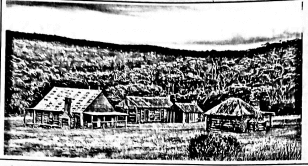
Nyumba ni makao ya mwanadamu. Kuna aina nyingi za nyumba. Kuna nyumba zinazojengwa kuelekea juu, vibanda, msonge, mapango, hema, tembe, za mawe, za udongo, za zege na kadhalika. Sehemu za nyumba ni sakafu, kuta, milango, vizingiti, madirisha, dari na paa.
Katika nyumba kuna makabati, makochi na viti. Mekoni kuna majiko, majokofu, karo, chanja, susu, sahani, vijiko, mabakuli na vinginevyo. Anayejenga nyumba za kawaida huitwa mjenzi na anaye jenga nyumba aushi za mawe ni mwashi.
Mwanadamu hutumia nyumba kama pahali pa kuishi, kulala, kupumzika, kujificha, kula na kupikia. Wasomi hutumia nyumba kwa masomo. Watu wengine pia hutumia nyumba kwa biashara.
Maswali
- Makao ya wanadamu ni
- makochi
- sakafu
- nyumba
- msitu
- Nyumba zinazojengwa nyingine zikiwa juu ya nyingine huitwa
- vibanda
- ghorofa
- vizingiti
- hema
- Ni aina ngapi za nyumba zilizotajwa kwenye kifungu?
- Tisa
- Saba
- Nane
- Sita.
- Sakafu iliyo juu ya nyumba huitwaje?
- Paa
- Dari.
- Kuta
- Gorofa.
- Anayejenga nyumba za mawe ni
- mjenzi
- mwokaji
- mjengaji
- mwashi.
Soma kisa kifuatacho kisha ujibu swali la 6 hadi 10.
Je, kwa nini mbuni ana shingo ndefu? Wajua kwa nini shingo hiyo haina manyoya? Zamani Mbuni na mamba waliishi pamoja. Walikuwa marafiki wakubwa. Waliishi kama ndugu lakini sidhani kama walipendana kwa dhati. Siku moja Mamba alihisi njaa. Alitafuta mizoga ya kula akakosa. Mbuni alikula mizizi ya miti na matunda ya porini. Yeye hakuwa na shida ya njaa,
Mamba alifikiri kitu ambacho angekula, akaona kuwa nyama ya karibu naye ni Mbuni. Akajifanya mgonjwa na kumwita Mbuni. Alimwambia kuwa jino lake lilikuwa linauma. Alimwomba aingize kichwa chake kwenye mdomo wake aone shida ya jino hilo.
Mbuni kwa kumhurumia Mamba akakubali. Alipoingiza kichwa mdomoni, Mamba alifunga kinywa ghafla. Mbuni alijivuta kwa nguvu sana hadi akatoka mdomoni mle. Ubaya ni kuwa, manyoya ya shingo yake yalibaki mdomoni mwa Mamba. Pia, shingo yake ilirefuka zaidi
Maswali
- Zamani, Mbuni na Mamba waliishi ______________________________
- majini
- pamoja
- kwa furaha
- nyumbani.
- Kwa kawaida chakula cha Mamba kilikuwa
- mbuni
- ndege
- mizizi
- mizoga.
- Mamba alipowaza sana alifanya nini?
- Alimla Mbuni.
- Aliingia majini.
- Alitamani kumla Mbuni.
- Alimkamata Mbuni.
- Kwa nini Mamba alijifanya kuumwa na jino? Alitaka
- kuling'oa jino
- kumnyoa Mbuni
- kumla Mbuni
- kuumwa na jino.
- Mbuni alikubali kufanya nini?
- Kumtibu Mamba.
- kumla Mamba
- Kung'oa jino.
- Kukiingiza kichwa kinywani mwa Mamb
Soma hadithi hii kisha ujibu maswali 11-15.
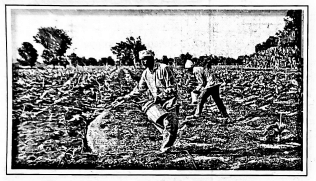
Kila asubuhi wakulima huenda kwenye makonde yao kulima. Baada ya siku nyingi wao hupanda mbegu. Mbegu zikiota hutokea miche. Miche hugeuka na kuwa mimea. Mimea hustawi kisha ikapaliliwa. Baada ya hayo, magugu yote hung'olewa. Mimea inazaa mazao. Mazao ya mimea yakikomaa huvunwa. Mavuno ya mimea hutumiwa kama chakula sana. Wengine huuza ili kupata pesa za kutumia nyumbani. Kazi ya ukulima ni nyingi na huchosha lakini ina faida sana! Kila kitu huanza mbali na hutengenezwa ili kiwe kizuri baadaye.
Maswali
- Wakulima huenda kulima kwenye ________________________________.
- ngumi
- mashamba
- mabonde
- makundi
- Baada ya kulima shamba mkulima hufanya nini?
- Huvuna
- Hupalilia.
- Hupanda mbegu.
- Huuza.
- Katika kupalilia, mkulima hutoa shambani magugu au ___________________________________.
- miche
- mbegu
- kwekwe
- mimea
- Wakulima hupalilia nini?
- Mazao
- Mimea
- Magugu.
- Mauzo.
- Wakati wa mavuno, wakulima huvuna
- mimea
- miche
- chakula
- mazao.
Soma kifungu kifuatacho kisha ujaze pengo 16 - 20 kwa jibu lifaalo zaidi.
Unga ___16___ ngano hutengeneza vyakula ___17___ kama vile ,chapati na ___18___. Jana nilikula andazi moja ___19___ chai kikombe __20__
nikashiba.
| A | B | C | D | |
| 16. | ya | za | la | wa |
| 17. | tamu | mamo | vitamu | matamu |
| 18. | maandazi | wali | vibanzi | mtama |
| 19. | na | kwa | ya | pamoja |
| 20. | moja | mbili | mmoja | kimoja |
Jibu maswali kulingana na maagizo.
- Tegua kitendawili hiki.
Ajenga ingawa hana mikono.- Kobe
- Ndege
- Konokono
- Kilema.
- Kinyume cha kumeza ni _________________________
- kutapika
- kutoa
- kula
- kutema.
- Bainisha neno lililopigiwa mstari. Nilienda ila sikumpata.
- kihusishi
- kiunganishi
- kihisishi
- kitenzi.
- Ipi ni nomino katika ngeli ya A-WA?
- Kiti
- Kitabu
- Kidole
- Kipepeo.
- Chagua wingi wa sentensi ifuatayo.
Mwaka umeanza.- Miaka zimeanza
- Mamiaka imeanza
- Miaka imeanza
- Mamiaka yameanza.
- Jaza pengo kwa neno la adabu linalofaa.
____________________________ Vicky, naomba kupita.- Simile
- Samahani
- Tafadhali
- Songea.
- Sehemu ya kompyuta inayoonyesha picha au maandishi huitwa
- kitufe
- kipanya
- kiwambo
- mashine.
- Tambua kivumishi katika sentensi hii.
Watoto wadogo walipata zawadi nyingi.- nyingi
- watoto
- zawadi
- pata
- Jaza pengo kwa usahihi.
Nzi ___ meruka- i
- u
- ki
- a
- Barua ya kindugu huwa na anwani moja ya
- rafiki
- mwandishi
- mwandikiwa
- msomi.
INSHA
Umepewa dakika 40 kuandika insha yako.
Andika insha ya maelezo kuhusu;
UMUHIMU WA MAJI.
______________________________________________________________________________________________________
______________________________________________________________________________________________________
______________________________________________________________________________________________________
______________________________________________________________________________________________________
______________________________________________________________________________________________________
______________________________________________________________________________________________________
______________________________________________________________________________________________________
______________________________________________________________________________________________________
______________________________________________________________________________________________________
______________________________________________________________________________________________________
______________________________________________________________________________________________________
______________________________________________________________________________________________________
______________________________________________________________________________________________________
______________________________________________________________________________________________________
______________________________________________________________________________________________________
______________________________________________________________________________________________________
MARKING SCHEME
- C
- B
- A
- B
- D
- B
- D
- C
- C
- D
- B
- C
- C
- B
- D
- D
- C
- A
- B
- D
- B
- A
- B
- D
- C
- A
- C
- A
- D
- C
English Language Questions and Answers - Grade 4 Mid Term 2 Exam 2023 Set 3
Read the following passage and answer questions 1-5.
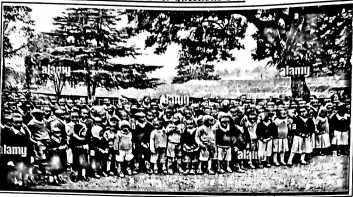
A school assembly is a gathering done on the assembly grounds to get information from teachers and the management. There are prayers and songs held at the beginning of assemblies.
There is a certain order to follow during assembly speeches. It starts with the school prefects and ends with the principals. An assembly takes 10 to 25 minutes.
Assemblies are important because they help pass information. They also enable teachers to inspect the hygiene of the learners. It helps to develop unity. It is also an avenue for good performance recognition by giving awards. The awards can be: mathematical sets, trophies or school shoes.
Questions
- What is a school assembly?
- A gathering that helps a preacher deliver his sermons.
- It is a school competition gathering.
- A gathering done to get information from teachers and the school management.
- A ceremonial wedding gathering.
- What is done at the beginning of a school- assembly?
- Screaming
- Prayers
- Competition
- Laughing.
- How long does an assembly take?
- 10 to 25 minutes.
- 10 to 48 minutes.
- 25 to 38 minutes.
- 30 minutes.
- The following are awards received during assemblies except
- mathematical sets
- trophies
- twigs
- school shoes.
- A school assembly speech follows a certain order. Which one is it?
- It starts with school prefects and ends with the principal.
- Starts with teachers and ends with the school prefects.
- Starts with the principal and ends with the teachers.
- The principal talks all through.
Read the dialogue below and answer questions 6 -10.
Hare: Good morning Hippo.
Hippo: Good morning Hare.
Hare: Why have you not gone to the farm?
Hippo: I have not gone to the farm due to the high rains that occurred yesterday. Hare: But Hippo, this is the right time to plant.
Hippo: I know, only that I don't feel like leaving this pool. I just want to swim Hare: That's laziness.
Questions
- How many animals are in the dialogue above?
- 6
- 7
- 3
- 2
- Why does hippo want to stay in the pool?
- He wants to swim.
- He wants to plant.
- He wants to watch animals.
- He is waiting for hare.
- When hare tells hippo that 'this is the right time to plant', what is Hippo's reply?
- 'Good morning hare'
- 'No, I don't know'
- 'This is the right time to plant'
- 'I just want to swim'
- When did the rains occur?
- Morning
- Last week.
- Supper time
- Yesterday.
- According to the dialogue, Hippo is described as
- lazy
- hardworking
- heavy
- joyful.
Read the following passage and answer the questions that follow.
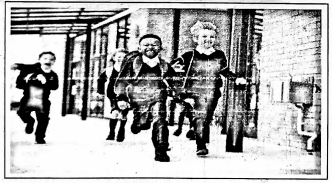
Mwaura is a ten-year old boy. He comes from Kiambu county. He loves eating chips and chicken. Mwaura is 1.3 metres tall.
He has two best friends. They are Njeri and Otieno. They love playing games together. They play football, basketball and netball together. They also go to the same school. Their school is known as Mirema Integrated School.
Last week, the three friends visited the Boma children's home. They gifted the children with food stuffs, balls and school shoes. The children at Bomą children's home appreciated their kindness.
Questions
- How old is Mwaura?
- 5 years old
- 6 years old
- 8 years old
- 10 years old
- How tall is Mwaura?
- 1.5m
- 1.3m
- 1.4m
- 1.6m
- How many best friends does Mwaura have?
- 4
- 6
- 2
- 1
- Which children's home did the friends visit last week?
- Gateru
- Boma
- Hola
- Mirema.
- What school do the friends go to?
- Boma children's home.
- International school
- Mirema Integrated school.
- Boma junior school.
Read the cloze test below and use the answers provided to fill the blanks.
My brother's name is Allan. He is ___16___ handsome boy. ___17___ are best friends. He likes ___18___ meat. His favourite pet is a ___19___. His pet loves meat.
He owns a ___20___ which he rides everyday. He loves going to the library. I love my brother very ___21___.
| A | B | C | D | |
| 16. | a | an | it | very |
| 17. | I | We | It | He |
| 18. | eats | ate | eated | eating |
| 19. | cat | ket | kettle | lion |
| 20. | palace | bicycle | car | lorry |
| 21. | more | much | few | a lot |
Choose the adverb in the following sentences.
- She walked quickly.
- she
- walked
- quickly
- walk
- He sang the song beautifully.
- beautifully
- sang
- the
- he
- He ate his food hurriedly.
- his
- ate
- hurriedly
- food
Give the plural of the sentences below.
- She gave me a pen.
- She gave us pens.
- They gave us pens.
- She gaves pens.
- We gave them pens.
- The tree has a fruit.
- The trees have fruits.
- The trees has fruits.
- The tree has a fruits.
- The trees has fruits.
Choose the correct sound of each animal.
- A donkey _________________________.
- brays
- sings
- chips
- trumpets.
- A bird __________________________.
- brays
- hisses
- trumpets
- chirps.
- An elephant __________________________________.
- hisses
- clucks
- trumpets
- chirps.
Use the correct conjunction to fill in the blank space.
- Mary _________________________Atieno came home.
- for
- and
- In
- but
COMPOSITION
You have 40 minutes to write your composition.
Write a composition about;
A ROAD ACCIDENT
__________________________________________________________________________________________________________
__________________________________________________________________________________________________________
__________________________________________________________________________________________________________
__________________________________________________________________________________________________________
__________________________________________________________________________________________________________
__________________________________________________________________________________________________________
__________________________________________________________________________________________________________
__________________________________________________________________________________________________________
__________________________________________________________________________________________________________
__________________________________________________________________________________________________________
__________________________________________________________________________________________________________
__________________________________________________________________________________________________________
__________________________________________________________________________________________________________
__________________________________________________________________________________________________________
__________________________________________________________________________________________________________
MARKING SCHEME
- C
- B
- A
- C
- A
- D
- A
- D
- D
- A
- D
- B
- C
- B
- C
- A
- B
- D
- A
- B
- B
- C
- A
- C
- B
- A
- A
- D
- C
- B
Mathematics Questions and Answers - Grade 4 Mid Term 2 Exam 2023 Set 3
QUESTIONS
- A farmer harvested 20314 apples in a certain village. What was the number of apples he harvested in words?
- Two thousand three hundred and fourteen.
- Twenty thousand three hundred and fourteen.
- Twenty thousand three hundred and forty.
- Two thousand three hundred and forty.
- The number of people who attended a new year crossover service were 19026. What is the place value of digit 9 in the number?
- Ten thousands
- Hundred thousands
- Hundreds
- Thousands
- Mandela added 4869 to 9432 and rounded off the answer to the nearest 100. What answer did he get?
- 14301
- 14300
- 14400
- 14330
- The difference between two numbers is 2335. If the smaller number is 909, find the bigger number.
- 1426
- 3244
- 2234
- 14365.
- In a class of 30 pupils, 17 are boys. What fraction of pupils are boys?
- 30/17
- 17/30
- 13/30
- 30/13
- One kilogram of sugar costs sh. 47. Find the cost of 7 kgs of sugar,
- Sh. 289
- Sh. 54
- Sh.40
- Sh.329
- A glass of water is 3/5 full. If I drink 1/5 of it, what fraction will remain?
- 2/5
- 4/5
- 3/5
- 5/2
- Pelister distributed 44 sweets equally among 8 children. How many sweets did Peach child get and how many sweets remained?
- 6 remainder 4
- 10 remainder 4
- 9 remainder 4
- 5 remainder 4
- Which of the following is an odd number?
- 184
- 144
- 169
- 156
- The classroom door is 235 cm long. What is the length in metres and centimetres?
- 2m 35cm
- 23m 5 cm
- 2m 350cm
- 23m 50cm
- Olwenga changed 92/5 into an improper fraction. What was his answer?
- 5/47
- 45/2
- 47/5
- 43/5
- 90 is a multiple of 18. What is the next multiple of 18 after 90?
- 72
- 108
- 54
- 126
- A shopkeeper packed 36kg of sugar into 1/4 kg packets. How many packets did he get?
- 9 packets
- 144 packets
- 36 packets
- 72 packets
- Mwelusi walked around the figure below once. What distance did he cover?
- 21m
- 24m
- 26m
- 30m
- A farmer harvested eight hundred and nine bags of wheat in 2007 and one thousand and three bags in 2008. How many more bags did he harvest in 2008 than 2007?
- 204
- 194
- 184
- 294
- 8 pencils cost sh. 72. What is the cost of one pencil?
- Sh. 9
- Sh. 18
- Sh. 27
- Sh. 64
- The perimeter of a square is 32cm. Find its length?
- 128 cm
- 64 cm
- 16 cm
- 8 cm
- In the figure below, what fraction is unshaded?
- 1/9
- 9/1
- 8/9
- 7/8
- A table has 24 plates. Each plate has 6 sweets. How many sweets are on the table altogether?
- 4
- 104
- 144
- 30
- Five children bought the following litres of juice from a shop; 2.5 litres, 2.25 litres, 4.5 litres, 2 litres and 3. 15 litres. Arrange the litres of juice from highest to the lowest.
- 3.15, 2.25, 4.5, 2.5, 2
- 4.5, 3.15, 2.5, 2.25, 2
- 2, 2.5, 4.5, 2.25, 3.15
- 2, 2.25, 2.5, 3.15, 4.5
- Mr. Kariuki had a string of 20 m 20 om. He divided it into 4 equal parts. What is the length of each part?
- 5m 5 cm
- 4m 4 cm
- 5 m 4 cm
- 4 m 4 cm
- Omino has seventy-eight thousand and ninety six cows. What is the number of cows Otieno has in symbols?
- 7896
- 17896
- 780096
- 78096
- A mason constructed a wall using stone blocks. The wall had 6 layers, 8 columns and 10 rows of blocks. How many cubes does the wall have?
- 24
- 240
- 120
- 480
- There are 2022 pupils in a school. 1019 are boys. How many girls are there?
- 1017
- 1003
- 3041
- 1000
- James is 90 cm tall and Irene is 89cm tall. Who is taller?
- James
- Irene
- James and irene
- None
- The table below shows the number of sweets eaten by two girls in three days
How many sweets did they eat on Monday and Wednesday altogether?Monday Tuesday Wednesday Venessa 2 1 3 Vera 4 4 2 - 11
- 6
- 10
- 12
- Grade 4 learners changed 7/10 into decimal. What was their answer?
- 0.007
- 0.77
- 7.7
- 0.7
- 1, 2, 3 and 5 are factors of a particular number. Which number is it?
- 30
- 11
- 25
- 15
- How many days are there in the months of July, August and September?
- 90 days
- 63 days
- 93 days
- 92 days
- One week has 7 days. 56 days have ____________________ weeks?
- 63
- 8
- 392
- 9
MARKING SCHEME
- B
- D
- B
- A
- B
- D
- A
- D
- C
- A
- C
- B
- B
- D
- B
- A
- D
- A
- C
- B
- A
- D
- D
- B
- A
- A
- D
- A
- D
- B


